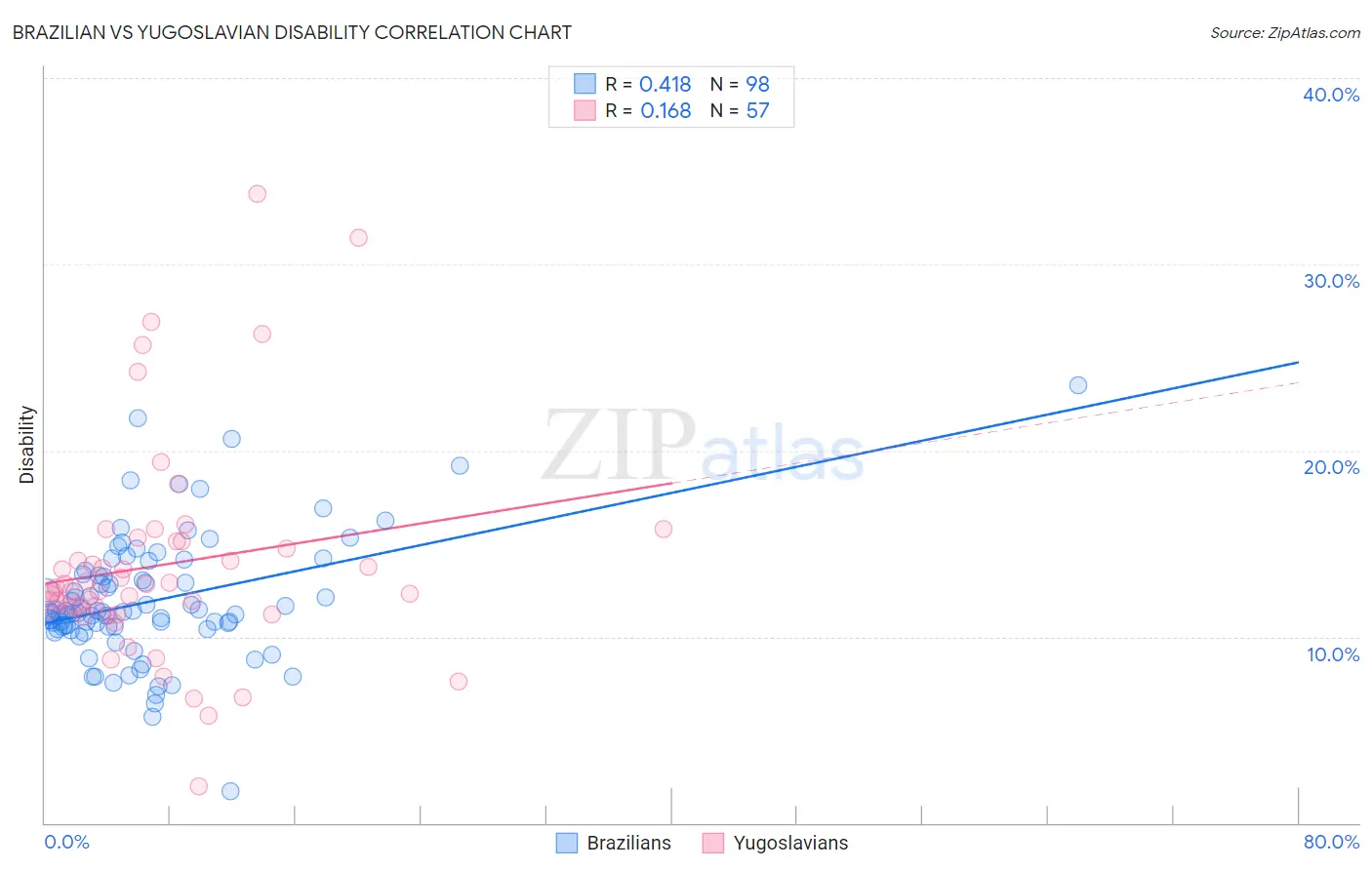Brazilian vs Yugoslavian Disability
COMPARE
Brazilian
Yugoslavian
Disability
Disability Comparison
Brazilians
Yugoslavians
11.4%
DISABILITY
93.3/ 100
METRIC RATING
122nd/ 347
METRIC RANK
12.2%
DISABILITY
1.7/ 100
METRIC RATING
241st/ 347
METRIC RANK
Brazilian vs Yugoslavian Disability Correlation Chart
The statistical analysis conducted on geographies consisting of 323,954,129 people shows a moderate positive correlation between the proportion of Brazilians and percentage of population with a disability in the United States with a correlation coefficient (R) of 0.418 and weighted average of 11.4%. Similarly, the statistical analysis conducted on geographies consisting of 285,695,841 people shows a poor positive correlation between the proportion of Yugoslavians and percentage of population with a disability in the United States with a correlation coefficient (R) of 0.168 and weighted average of 12.2%, a difference of 7.6%.

Disability Correlation Summary
| Measurement | Brazilian | Yugoslavian |
| Minimum | 1.7% | 2.0% |
| Maximum | 23.5% | 33.8% |
| Range | 21.8% | 31.8% |
| Mean | 11.9% | 13.9% |
| Median | 11.3% | 12.6% |
| Interquartile 25% (IQ1) | 10.5% | 11.4% |
| Interquartile 75% (IQ3) | 13.3% | 15.1% |
| Interquartile Range (IQR) | 2.8% | 3.8% |
| Standard Deviation (Sample) | 3.3% | 5.8% |
| Standard Deviation (Population) | 3.3% | 5.8% |
Similar Demographics by Disability
Demographics Similar to Brazilians by Disability
In terms of disability, the demographic groups most similar to Brazilians are Immigrants from Costa Rica (11.4%, a difference of 0.020%), Immigrants from North Macedonia (11.4%, a difference of 0.030%), Central American (11.4%, a difference of 0.040%), Korean (11.3%, a difference of 0.090%), and Luxembourger (11.3%, a difference of 0.10%).
| Demographics | Rating | Rank | Disability |
| Immigrants | Philippines | 94.6 /100 | #115 | Exceptional 11.3% |
| Immigrants | Northern Europe | 94.1 /100 | #116 | Exceptional 11.3% |
| Luxembourgers | 93.9 /100 | #117 | Exceptional 11.3% |
| Koreans | 93.8 /100 | #118 | Exceptional 11.3% |
| Central Americans | 93.5 /100 | #119 | Exceptional 11.4% |
| Immigrants | North Macedonia | 93.5 /100 | #120 | Exceptional 11.4% |
| Immigrants | Costa Rica | 93.4 /100 | #121 | Exceptional 11.4% |
| Brazilians | 93.3 /100 | #122 | Exceptional 11.4% |
| South Africans | 92.3 /100 | #123 | Exceptional 11.4% |
| South American Indians | 92.2 /100 | #124 | Exceptional 11.4% |
| Costa Ricans | 91.9 /100 | #125 | Exceptional 11.4% |
| Immigrants | Latvia | 90.9 /100 | #126 | Exceptional 11.4% |
| Immigrants | Italy | 90.4 /100 | #127 | Exceptional 11.4% |
| Immigrants | Europe | 90.4 /100 | #128 | Exceptional 11.4% |
| Macedonians | 90.3 /100 | #129 | Exceptional 11.4% |
Demographics Similar to Yugoslavians by Disability
In terms of disability, the demographic groups most similar to Yugoslavians are Hungarian (12.2%, a difference of 0.0%), Polish (12.2%, a difference of 0.020%), Swedish (12.2%, a difference of 0.050%), Norwegian (12.2%, a difference of 0.090%), and British (12.2%, a difference of 0.11%).
| Demographics | Rating | Rank | Disability |
| Japanese | 2.3 /100 | #234 | Tragic 12.2% |
| Yup'ik | 2.2 /100 | #235 | Tragic 12.2% |
| Chinese | 2.0 /100 | #236 | Tragic 12.2% |
| Immigrants | Congo | 1.9 /100 | #237 | Tragic 12.2% |
| Norwegians | 1.9 /100 | #238 | Tragic 12.2% |
| Swedes | 1.8 /100 | #239 | Tragic 12.2% |
| Hungarians | 1.7 /100 | #240 | Tragic 12.2% |
| Yugoslavians | 1.7 /100 | #241 | Tragic 12.2% |
| Poles | 1.7 /100 | #242 | Tragic 12.2% |
| British | 1.5 /100 | #243 | Tragic 12.2% |
| Basques | 1.5 /100 | #244 | Tragic 12.2% |
| Liberians | 1.5 /100 | #245 | Tragic 12.2% |
| Swiss | 1.5 /100 | #246 | Tragic 12.2% |
| Indonesians | 1.4 /100 | #247 | Tragic 12.2% |
| Guamanians/Chamorros | 1.4 /100 | #248 | Tragic 12.3% |